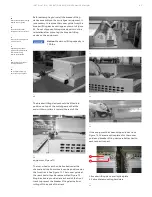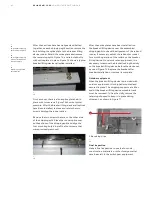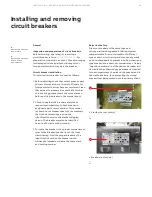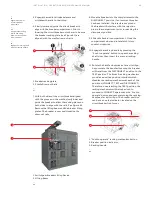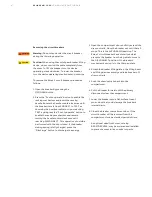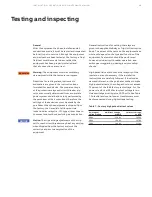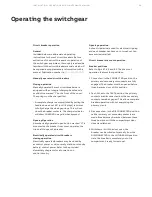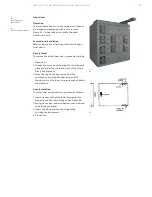
41
R E LI AG E A R® LV SG
LO W VO LTAG E S W I TC H G E A R
—
66
Typical cable lashing
—
66
This should result in the oozing of compound
material from between individual strands.
Wipe off any excess compound.
Bolt the cable terminal connectors to the ends of
the bars in the cable compartment. A non-oxidizing
grease should be used at these connection
surfaces. The bolts should be tightened in
accordance with values shown in the torque
Table A.2 in Appendix A of this instruction book.
Lash the cables securely to the cable support, if
present, to take their weight off the runbacks and
to brace them against short circuit forces in the
event of a fault.
Cable supports can be optionally ordered from the
factory. The following instructions for cable lashing
should be used as a guide and Figure 66 details a
typical cable lashing diagram. Run and bend the
main cable in a most convenient orientation,
making sure the main cable has been located
directly up against any cable braces (if present)
before it connects to the main cable terminals.
Using a 3/8 inch diameter continuous nylon rope
or equivalent (minimum 2000 pounds tensile
strength) at 6 inches from the main cable terminals,
make five revolutions around the "A" and "B" phase
main cables, making sure the rope does
not overlap.
Make five revolutions around the "B" and "C" phase
main cables. With the remaining rope, wrap around
the main cable lashing between the "B" and "C"
phase and the cable brace (if present) with a
minimum of 5 revolutions getting as much
revolutions as possible between the phases.
Continue wrapping between the "A" and "B" phase
around the main cable lashing and the cable brace
(if present) with a minimum of 5 revolutions
getting as much revolutions as possible between
the phases. Securely tie off the remaining rope.
Repeat this lashing at every 6-inch interval.
Relays and control devices
Remove all blocking on relays and devices as shown
in the instructions accompanying the devices.
Breaker lifting device
Indoor equipment
Figure 67 shows the breaker lifting device
assembled on indoor switchgear equipment. When
supplied with indoor equipment, the breaker lifting
device is shipped in a separate carton completely
assembled, Figure 68.
—
67
—
68
—
67
Breaker lifting device
assembly (indoor
equipment)
—
68
Carton containing
breaker lifting device
















